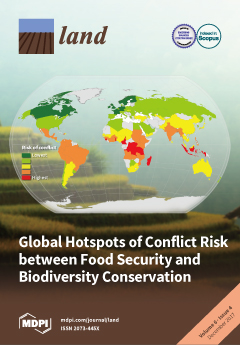Resources
Displaying 1956 - 1960 of 2258Monitoring Changes in Croplands Due to Water Stress in the Krishna River Basin Using Temporal Satellite Imagery
Remote sensing-based assessments of large river basins such as the Krishna, which supplies water to many states in India, are useful for operationally monitoring agriculture, especially basins that are affected by abiotic stress. Moderate-Resolution Imaging Spectroradiometer (MODIS) time series products can be used to understand cropland changes at the basin level due to abiotic stresses, especially water scarcity.
Constraining the Deforestation History of Europe: Evaluation of Historical Land Use Scenarios with Pollen-Based Land Cover Reconstructions
Anthropogenic land cover change (ALCC) is the most important transformation of the Earth system that occurred in the preindustrial Holocene, with implications for carbon, water and sediment cycles, biodiversity and the provision of ecosystem services and regional and global climate. For example, anthropogenic deforestation in preindustrial Eurasia may have led to feedbacks to the climate system: both biogeophysical, regionally amplifying winter cold and summer warm temperatures, and biogeochemical, stabilizing atmospheric CO 2 concentrations and thus influencing global climate.
Pastoralism and Land Tenure Transformation in Sub-Saharan Africa: Conflicting Policies and Priorities in Ngamiland, Botswana
In dryland Africa, access to land and water resources are central to pastoral livelihood activities. Policy intervention in these regions represents the outcome of concerted post-independence processes in which countries have committed to land tenure transformation as a policy objective. This was meant to create private, liberal property rights to replace communal customary tenure systems which were considered to be a constraint to development. Despite these efforts, decades of scientific research indicate that countries are still struggling to meet environmental sustainability objectives.
Identifying Hot Spots of Critical Forage Supply in Dryland Nomadic Pastoralist Areas: A Case Study for the Afar Region, Ethiopia
This study develops a methodology to identify hot spots of critical forage supply in nomadic pastoralist areas, using the Afar Region, Ethiopia, as a special case. It addresses two main problems. First, it makes a spatially explicit assessment of fodder supply and demand extracted from a data poor environment. Fodder supply is assessed by combining rainfall-based production functions and rule-based assessment for prevailing land use. Fodder demand is based on a data consistency check of livestock statistics concerning herd size, composition and geographical distribution.
Simulating Stakeholder-Based Land-Use Change Scenarios and Their Implication on Above-Ground Carbon and Environmental Management in Northern Thailand
The objective of this study was to examine whether the coupling of a land-use change (LUC) model with a carbon-stock accounting approach and participatory procedures can be beneficial in a data-limited environment to derive implications for environmental management. Stakeholder-based LUC scenarios referring to different storylines of agricultural intensification and reforestation were simulated to explore their impact on above-ground carbon (AGC) for a period of twenty years (2009–2029). The watershed of Mae Sa Mai, Northern Thailand was used as a case study for this purpose.


